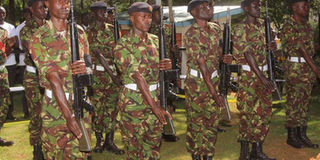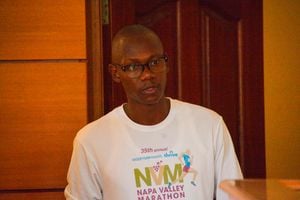El-Adde: Lessons learnt and way forward

Soldiers during the burial of the late Wesley Sirikwo at Lelmokwo, Nandi County on February 3, 2016. Sirikwo, a Kenya Defence Forces soldier, was killed by Al-Shabaab at El-Adde camp in Somalia last month. PHOTO | JARED NYATAYA | NATION MEDIA GROUP
What you need to know:
- The terrible attack on Kenya Defence Forces troops at El-Adde in the Gedo region of Somalia last month offers an opportunity to change things for the better.
- First, there might be a temptation to keep a hold on the casualty figures, for a number of reasons, including the impact on domestic inter-ethnic relations, or the reflection on the competency of those involved.
- There needs to be an immediate lessons-learned process identifying quick wins — generally changes to tactics and procedures — and, even more importantly, a longer term analysis that evaluates the overall security capability.
- A third lesson is in ownership of the problem — in essence, the threat posed by radical Islam to Kenya from both without and within — and the solution.
- The fourth and final pointer is to evaluate Kenya’s strategy in Somalia.
The terrible attack on Kenya Defence Forces troops at El-Adde in the Gedo region of Somalia last month offers an opportunity to change things for the better if the right process can be followed, and lessons identified and learnt.
It was a tragic event for Kenya, for the armed forces and particularly, for the families of the soldiers involved. In war, such hard knocks are not uncommon, they are the price of conflict. To prevail, it is important that lessons are learnt and reforms made.
Four pointers stand out in the circumstances: First, there might be a temptation to keep a hold on the casualty figures, for a number of reasons, including the impact on domestic inter-ethnic relations, or the reflection on the competency of those involved.
But warfare is as much about perception as it is about reality and Al-Shabaab have gained much from their quick release of images. Bad news generally does not get better and in the absence of information, people make it up to be generally worse than it is.
The Kenyan Government needs to get accurate information into the public domain as soon as the families of the casualties have been informed.
CATALYSED IMPROVEMENTS
The public reaction will, second, depend on how the government responds to this event. The best that could come out of it is that it is seen as the event that catalysed improvements.
There needs to be an immediate lessons-learned process identifying quick wins — generally changes to tactics and procedures — and, even more importantly, a longer term analysis that evaluates the overall security capability.
The Colombian military, to take an example from another counter-insurgency campaign, used its humiliation in Mitu in 1998 when FARC guerrillas overran an army battalion and police unit killing 150 personnel and capturing more than 40 soldiers, to reorganise.
Mitu was evidence of the strength of their foe and the relative weakness of the Colombian State, a realisation that led to a rapid increase in the size of the armed forces and better equipment, improved intelligence collection and fusion, and inter-operability between the army, air force, navy and marines, and police.
A third lesson is in ownership of the problem — in essence, the threat posed by radical Islam to Kenya from both without and within — and the solution.
This is not the military’s problem alone. Again, the lesson from Colombia is the need for a whole of government approach, including the treasury, social services, foreign ministry, police, intelligence services, and the military.
RESOURCE CHOICES
Ultimately, for example, some hard resource choices will have to be made as to where and on which equipment and people money is to be spent. The toughest choice overall will likely be about the size of the military.
Given Kenya’s long borders and its missions in Somalia and South Sudan, it seems that the current size of the KDF troops is just too small, and that too much of its $1 billion budget is not spent in the right areas.
The fourth and final pointer is to evaluate Kenya’s strategy in Somalia.
To be sustainable, any military action has to be led or, at least, paralleled by local political developments. There remain intrinsic problems with governance in Somalia, stemming from the historical impossibility of governing Somalis, from without and within.
Once a basis of social stability and consensus, the clan system is now routinely a source of power and control outside of government.
So far, both President Uhuru Kenyatta and KDF chief General Samson Mwathethe have reiterated Kenya’s commitment to the Somali operation.
This should not obscure the importance of using the El-Adde attack to conduct a thorough review of Kenyan tactics, capabilities and the overall strategy to contain the threat posed by radical Islamic groups.
Davis, who retired from the British Army last year after 32 years of service as a major general, and Dr Mills are with the Johannesburg-based Brenthurst Foundation.




